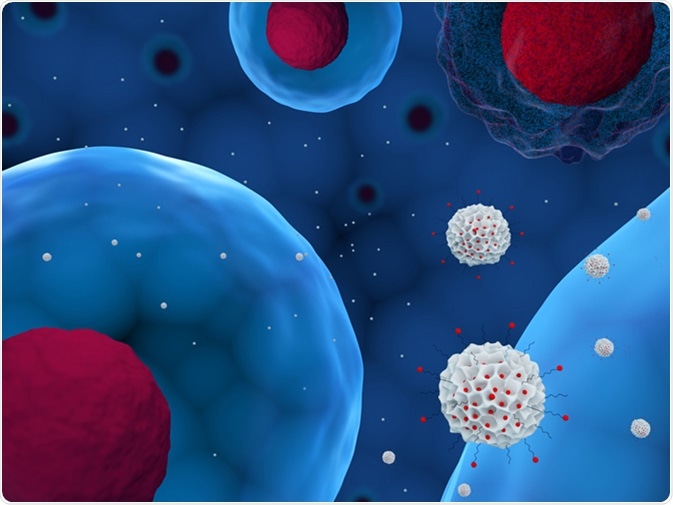Silica nanoparticles of between 1 – 100 nm in diameter are cost-effective and simple to produce, with a highly modifiable surface chemistry, shape, and size. They commonly act as a support scaffold or coating for biomolecules or other nanoparticles and potentially make excellent drug delivery platforms due to their highly biocompatible nature and porous structure.

3d illustration of mesoporous silica nanoparticles delivering drug to cells. Image Credit: Meletios Verras / Shutterstock
Biocompatibility
Silica is frequently used as an inert, non-toxic coating for other types of the nanoparticle, which is biodegradable within a reasonable timescale, ensuring a minimal level of bioaccumulation. These other nanoparticles may be acting as contrast agents or radiation dose enhancers, among other functions, and may be made from gold, silver, iron oxide, polymers, or other materials. A silica coating protects these materials from interaction with biomolecules present in a biological medium that may induce early excretion, or prevent the nanoparticle from completing its intended function. Additionally, a silica coating presents an easily customizable surface chemistry for the attachment of targeting molecules.
Silica Nanoparticle
Surface Chemistry
Silica nanoparticles present an exposed hydroxyl group at their surface which allows for conjugation with various molecules. The attachment of molecules to the surface of silica nanoparticles usually takes place through post-synthetic grafting, where a molecule able to bond with silica’s silanol group is added after the particle is already formed. Another method, co-condensation, incorporates the molecule to be attached into the synthesis of silica nanoparticles, ensuring a complete coating on both the exposed surface and internal porous area.
Targeting biomolecules such as polysaccharide chains, antibodies, DNA, other types of proteins or novel molecules can be attached to the surface of the nanoparticle, encouraging them to locate and enter specific tissues and cells within the body.
The surface chemistry of silica nanoparticles also provides applications in biosensing both in vitro and in vivo. DNA can be detected, separated, and purified easily using silica nanoparticles through electrostatic, hydrophobic, and hydrogen bonding interactions that take place between them.
Porous Structure
Silica nanoparticles are highly porous, providing a large protected internal surface area on which drugs can be bound for delivery. Other materials, such as cadmium sulfide, are used to block the entrance to these pores until chemically triggered to open when in the target drug delivery location.
Stabilizer
Silica is used as a stabilizer due to its ability to absorb water, thanks to the presence of polar hydroxyl groups attached to silicon molecules at the surface of the material, and the high surface area of the silica nanoparticle. Silica is incorporated into medicines for this purpose, with aspirin tablets often containing an optimum of 3% silica. Silica nanoparticles are also used as a glidant, added to medicines when in powder form to improve the ability to pour and shape the powder before compression into a tablet.
Bactericidal and Viricidal Agents
Silica nanoparticles may play a direct or supporting role in the development of nanomedicines intended to destroy bacteria or viruses.
Positively charged silica particles have been shown to accumulate near the cell wall of bacteria, due to the slightly negative charge that bacteria possess. The comparatively simple cell surface of bacteria compared with mammalian cells, consisting largely of lipopolysaccharide chains, allows hydrogen bonds to form with the silanol groups of silica, drawing the particles into the bacteria. The lower pH of the lysosomal compartment within the bacterium is then able to trigger the simultaneous release of potentially a variety of antibiotic drugs directly into the bacterium, lowering the opportunity for it to develop resistance by gradual exposure.
Current antiviral drugs are limited by poor solubility in water, low retention time in the body, and slow uptake throughout the body where they are needed. These shortcomings can be improved by incorporation with silica nanoparticles as delivery vehicles, improving biodistribution throughout the body and increasing the probability of entering currently infected cells to deliver a payload of viricidal agents.
Further Reading